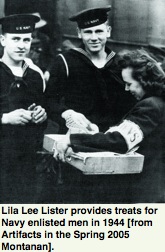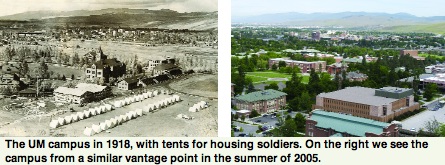Editor's Desk
Questions Not Asked
|
SEND US YOUR MAIL The Montanan welcomes letters to the editor. We ask that letters be signed and include the writer’s graduating year or years when appropriate, home address, and phone number or e-mail address. Send them to:
Montanan Editor Unfortunately, because of space limitations we are not able to include all letters sent to us. Letters that appear are often edited for length or clarity.
While universities are places of discussion where people of good will do not always agree, letters deemed potentially libelous or that malign a person or group will not be published. Opinions expressed in the Montanan do not necessarily reflect those of The University of Montana. |
||
It’s funny what you learn through a readership survey. The Montanan staff conducted a telephone survey in May using volunteers from University Relations, the UM Foundation, the Alumni Association, and UM Student Advocates. I was around to organize things, and what I found most enjoyable was the bubbling over of voices when callers took a break from the phones. They were retelling stories and anecdotes gathered from our readers.
I learned more about the raven that was mentioned in the story on John J. Craighead in our last issue. It seems Craighead’s raven friend, Rudy, who visits him almost daily at his home near Miller Creek in Missoula, is a neighborhood pest. One of the women who participated in the survey said Rudy should have gotten more space in the article because he’s quite a prankster. John’s neighbors have had to bird-proof their mailboxes; it seems, among other hi-jinks, Rudy has developed a penchant for raiding mail.
A man who received an MFA from UM’s creative writing program shared various stories about Richard Hugo with our caller. He talked about the first reading series the creative writing folks held in a bar in Missoula and the caller and volunteer agreed it was an experience to hear Hugo read his own poems.
Another man asked, “What ever happened to David Rorvik?” Rorvik was a talented and controversial Montana Kaimin editor in the late ’60s who went on to write science pieces for Time and the New York Times. In the late ’70s he created a controversy with the publication of In His Image: The Cloning of a Man. I thought I’d google him and see what came up. I found Rorvik is still writing science pieces and publishing books. His latest book is How to Choose the Sex of Your Baby. One blog I found went into quite a discussion of In His Image and mentioned that Rorvik had defended his earlier book in an article in a 1997 Omni, which came out after the first sheep cloning. I checked the Mansfield Library to see if they had Omni and learned it had gone out of publication in 1995, so the 1997 date obviously was wrong. I tried to find Omni online, but when I typed in the URL, I was taken directly to Penthouse magazine. Weird. I then went to the library to view the last few years of Omni’s publication, but found nothing, and other searches for articles on Rorvik and cloning also came up short.
I checked to see if he gets the Montanan. Our alumni list has him living in Portland, Oregon; no phone number listed, obviously. That would be too easy. What a strange trip I was on. It was time to quit and get back to the magazine. If you read this, David, phone home and let us know what you’re up to.
Another man, an octogenarian, told a caller a little about his life, one clear high point being,“I married this little girl from Dillon.”
One man, who received a master’s degree in geology from UM in 1960, talked about his time in Missoula and how the University and town have changed since he was here as a married grad student. The volunteer, used to spending a short time with each caller, found herself sitting back in her chair and listening to the man’s story. He said he never once went to the movies because he was so poor and he worked all the time; his social life consisted of having a beer occasionally with neighbors. (Some students might argue it’s not a whole lot different today.) He told stories about living in a Forest Service cabin in the Whitefish region in 1959. He said he was the geologist who eventually mapped that entire region.
If the participants stayed with us through the survey, they were eligible to win a $100 gift certificate from UM’s Bookstore. When one woman heard that, she said, “Oh, boy, more sweatshirts!”
We had the predictable hang-ups and “can you call another time; we’re about to eat dinner” replies, but more people than not were willing to talk with our volunteers. One participant offered that he also received Notre Dame’s magazine and he liked the Montanan better. Ah ..... I’ll take it, even if it is a little over the top.
We will use the results of the survey in charting our course over the next few years. We’ve learned a lot. And, as usual, some of the more poignant things we learned were things we never asked about. Kudos to volunteers and participants alike.
Joan Melcher
Editor, Montanan
Letters
Artifacts Identity Revealed

Dear Editor Joan:
Love the Montanan ... and read every word! Imagine my surprise when I got to the last page [of the Spring 2005 issue], “Artifacts” and saw my picture! The one with the sailors and the girl with the AWVS armband. Here’s the story about it: It was taken at the Northern Pacific Depot, some time in the fall of 1944. Many troop trains came through Missoula from the Great Lakes Naval Training Station on their way to port of embarkation at Seattle. Other trains came with soldiers, going to Fort Lewis or other POE destinations. Since it was wartime, troop movement was carefully kept confidential. But the station master would know when a troop shipment was coming, and if the hour was convenient, he would call Mrs. Mulroney, wife of Thomas Mulroney, a prominent local attorney. [She] was the coordinator of American Women’s Voluntary Services for Missoula.
If appropriate to serve the train, she would call a few of the carefully selected girls at the U to spread the word and time for the AWVS volunteers to show up at the depot. Those of us who could take the time that day would pick up our armbands and the filled boxes for distribution and go to the depot. The box I’m holding probably had donuts for the fellas. Other days it might have been sandwiches, cookies, candy bars, or even cigarettes. Then back to classes without telling anyone about the train. So, that’s the story. Thanks for the memories!
Lila Lee Lister (now Lincoln) ’47
Sacramento, California
Then and Now
 Editor’s Note: While participating in our readership survey, Joann Cline Reksten ’50 asked Alumni Association writer Betsy Holmquist (and survey volunteer) if she’d like to see a photo of the UM campus in 1918 that her father had sent. Betsy said of course and she has shared it with us.
Editor’s Note: While participating in our readership survey, Joann Cline Reksten ’50 asked Alumni Association writer Betsy Holmquist (and survey volunteer) if she’d like to see a photo of the UM campus in 1918 that her father had sent. Betsy said of course and she has shared it with us.
The photo that appears on the opposite page was printed on a postcard sent by John Cline ’24 to his family in Polson. The image shows the tents that were the homes of soldiers during the First World War. John Cline wrote on the back of the postcard:
I am sending a picture of our camp. Behind the grandstand is gym. We have mess there now. Clock to left is Science Bldg. Beyond Main Hall is library. Right behind tents is the new barracks. Our tent is marked x. The long street is Pershing St. Other is Liberty. Back of buildings is campus. Each platoon is going to have a football team. If you find any heavy underware [sp] you might send it down for we probably won’t have suits for some time.
John
More on Emma
While reading the last Montanan magazine, I saw the picture of Mrs. Emma Lommasson. It reminded me of a time back in Great Falls around 1943. I am one of the Fort Missoula internees, not a prisoner. I came out from the Fort and went to work at the Columbus Hospital in Great Falls.
The first time I met this beautiful lady was at a friendly house; after seeing her I lost my speech. While living in Great Falls, I was acquainted with her mother. While telling many stories of the old country, she used to fry eggs that I enjoyed very much.
Around 1951, I moved to Missoula and attended one quarter at the University. Mrs. Lommasson helped me a lot. If I would have listened to her, my scholastic situation would have been much different. But dreams fly like bees and I soon moved to the Seattle University. Emma continued to help me, even when I was at the University of California.
By the way, I was born November 22, 1911. This is an exception to the rule because I never tell my age. I have been around the University since 1941. I could tell you many stories, but I talk very little. I have, however, published eight books that can be found at the Mansfield Library.
Umberto Benedetti
Missoula
Voluntary Grace
Dear Montanan Editor:
Because of feeling guilty for the freeloading of the Montanan for quite a few years, I now am enclosing a check for $40 to pay for my subscription.
Of course, I have another reason for being so generous—that “Montanan, Wherever I Am” cap that you are offering as a gift (bribe). I will make good use of the cap since I am a snowbird, heading to points south every winter.
I closed a small retail business in San Diego in 2000 and retired back to Montana. Thanks for the Montanan. I always read it cover to cover.
Jim Hutchinson ’60
Hamilton
Here is my voluntary subscription to the best university magazine out there. Read every page. Keep up the great work.
Robert W. Squires ’56
San Antonio, Texas
This Spring 2005 issue of the Montanan is the most interesting issue I’ve ever received. Thank you!
Willa Hall ’53
Sequim, Washington
![]()
![]()